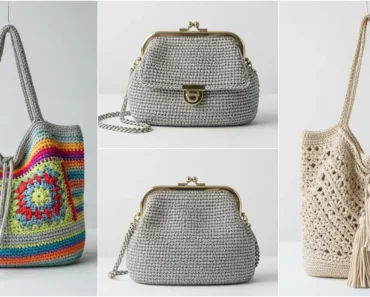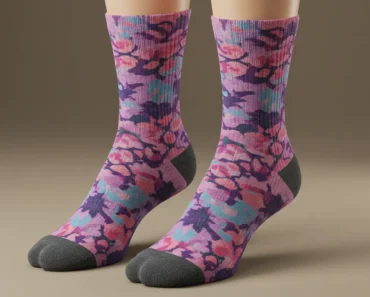Sea Glass Jewelry: Unearthing Treasures from the Tides. This guide explores the captivating beauty and unique appeal of jewelry crafted from ocean-tumbled glass, delving into its origins, characteristics, and the artistry involved in transforming beach finds into wearable art.
The Allure of the Ocean’s Gems: Why Sea Glass Jewelry Captivates
Imagine glass, once discarded and broken, transformed by the relentless tumbling action of ocean waves and abrasive sand. Over decades, sometimes even centuries, sharp edges soften, surfaces smooth, and a frosted, ethereal patina develops. This natural metamorphosis creates sea glass, a unique material that carries the history of the ocean within its very essence. When this glass is then crafted into jewelry, it becomes more than just an accessory; it is a piece of art, a tangible connection to the sea, and a story waiting to be told. This inherent charm is why Sea Glass Jewelry holds such enduring allure.
The appeal of Sea Glass Jewelry lies in its organic beauty and individuality. No two pieces of sea glass are exactly alike. Each shard boasts a unique shape, size, color, and level of frosting, shaped by its specific journey through the tides. This makes every piece of jewelry truly one-of-a-kind. It offers a refreshing alternative to mass-produced items, resonating with those who seek authenticity and a connection to nature. Owning Sea Glass Jewelry means carrying a whisper of the ocean, a piece of forgotten history, and a testament to nature’s transformative power.
Beyond its aesthetic charm, Sea Glass Jewelry often carries a sense of nostalgia and wonder. It reminds us of beachcombing, coastal adventures, and the vast mysteries of the ocean. It represents a commitment to sustainability, transforming discarded materials into beautiful, wearable art. This unique combination of natural beauty, history, and ecological mindfulness makes Sea Glass Jewelry a cherished and meaningful choice for many.
Key Characteristics Defining Authentic Sea Glass for Jewelry
Not all glass found on beaches qualifies as true sea glass. Authenticity is crucial for Sea Glass Jewelry, determining its value, beauty, and unique appeal. Understanding these characteristics helps distinguish genuine ocean treasures.
The Frosted Patina: Nature’s Signature
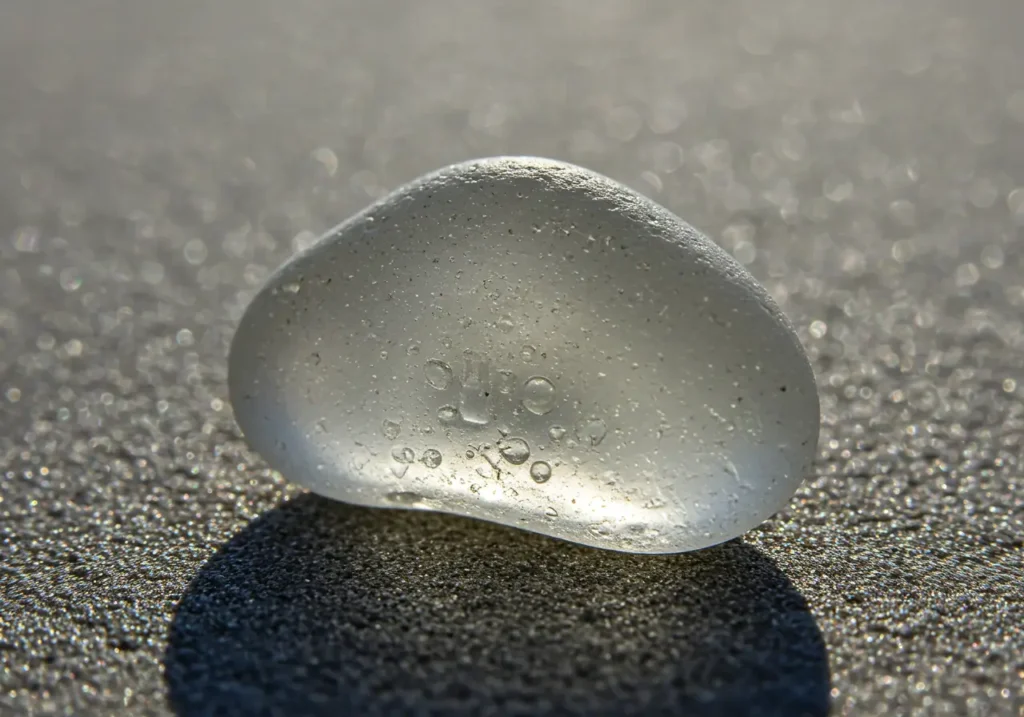
The most defining characteristic of authentic sea glass is its frosted, matte surface. This occurs due to continuous tumbling in saltwater, which causes the glass’s outer layers to hydrate and form tiny C-shaped pits. Over time, these microscopic pits refract light, giving the glass its characteristic frosted, ethereal appearance. Fake sea glass (tumbled in machines) often has a duller, more uniform frost or may feel gritty, lacking the true ocean-tumbled texture. This patina is the primary indicator for true Sea Glass Jewelry.
The degree of frosting indicates its age and the intensity of its tumbling journey. Highly frosted pieces are generally older and more prized.
Smooth, Rounded Edges: No Sharpness Allowed

Authentic sea glass will have smooth, rounded edges from years of tumbling against sand and rocks. There should be no sharp or jagged edges remaining. The more rounded and perfectly smoothed a piece is, the longer it has spent in the ocean. This process ensures the glass is safe to handle and wear in Sea Glass Jewelry.
Feel the piece with your fingers. It should feel smooth and comforting, without any abrasive points.
Unique Shapes and Irregularities: Nature’s Artistry
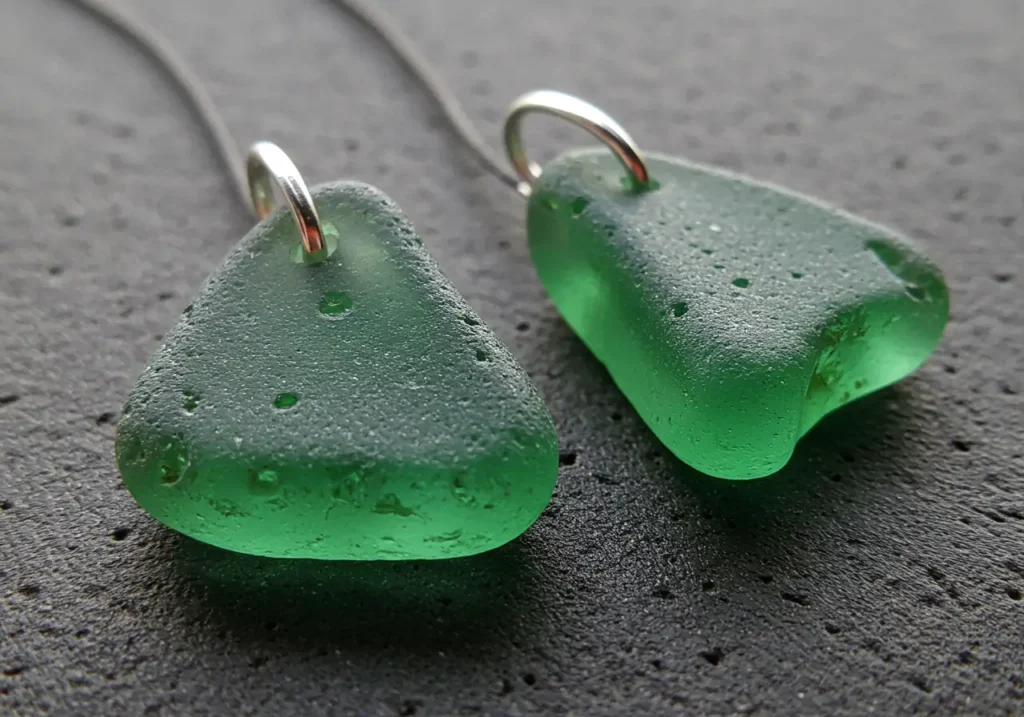
Each piece of authentic sea glass possesses a unique, irregular shape, molded by the unpredictable forces of the ocean. Unlike machine-tumbled glass which often has a uniform, artificial look, genuine sea glass will have varied contours, dimples, and sometimes even remnants of its original bottle or object shape. These irregularities add to its charm and individuality. This natural artistry makes every piece of Sea Glass Jewelry one-of-a-kind.
The absence of a perfect symmetry highlights its organic journey through the tides.
Rarity of Colors: The Collector’s Quest
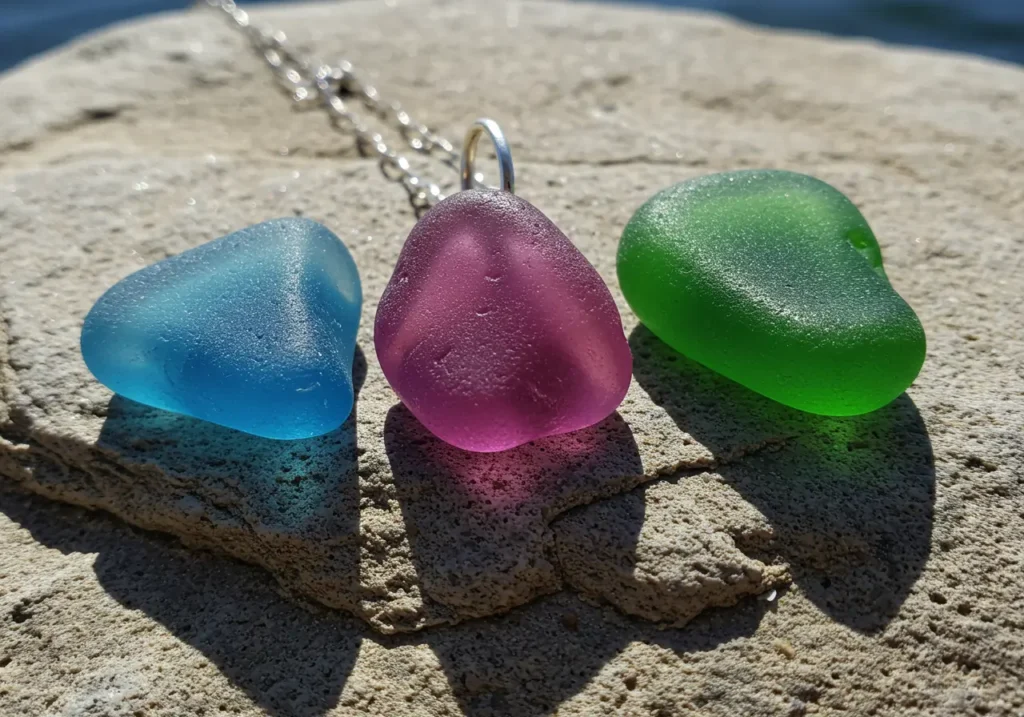
The color of sea glass often reflects its original source. Common colors include clear, brown (from beer or medicine bottles), and green (from soda or wine bottles). Rarer colors are blues (from medicine bottles, soda bottles), purples (from old clear glass that turned purple with sun exposure), and pinks. Extremely rare colors include red (from car taillights, ship lanterns), orange, yellow, and black (often very old, dark green that appears black). The rarity of the color significantly impacts its value in Sea Glass Jewelry.
Rare colors indicate older glass or unique origins, making them highly prized by collectors and jewelers.
Crafting Sea Glass Jewelry: The Art of Transformation
Transforming raw sea glass into wearable art requires skill, patience, and an understanding of how to highlight each piece’s unique beauty. Jewelers employ various techniques to create stunning Sea Glass Jewelry.
Wire Wrapping: Emphasizing Natural Form

Wire wrapping is a popular technique for Sea Glass Jewelry. It involves delicately encasing the sea glass in wire (sterling silver, gold-filled, or copper) without drilling or altering the glass itself. This method allows the natural shape and texture of the sea glass to remain central to the design. It creates a rustic, organic aesthetic. Wire wrapping highlights the glass’s unique contours.
This technique is often favored by artisans who want to preserve the glass in its found state.
Bezel Setting: A Polished Presentation

Bezel setting involves creating a custom metal rim (bezel) that perfectly encases the sea glass. This provides a secure and polished presentation, similar to how traditional gemstones are set. The metal frame often complements the sea glass color. This method is common for rings, pendants, and earrings, offering a more refined and contemporary look. It provides maximum security for the glass.
Drilling and Adorning: Creative Integration
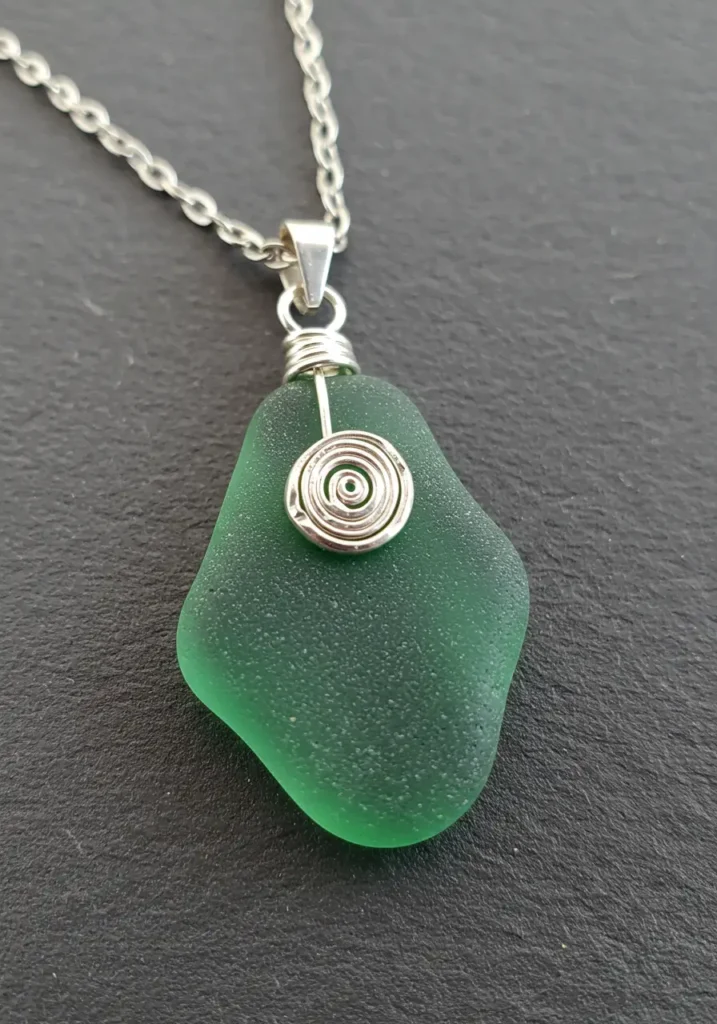
For some designs, jewelers carefully drill a small hole through the sea glass to attach a bail, jump ring, or chain. This technique allows for more minimalist designs or the integration of the sea glass into multi-component pieces. Drilling requires specialized tools and expertise to prevent cracking. Once drilled, sea glass can be combined with beads, small charms, or other metal elements for intricate designs. This creates unique and personalized Sea Glass Jewelry.
Popular Types of Sea Glass Jewelry
Sea glass’s versatility lends itself to various jewelry forms. Each type highlights the unique beauty of the glass in different ways.
Sea Glass Necklaces and Pendants
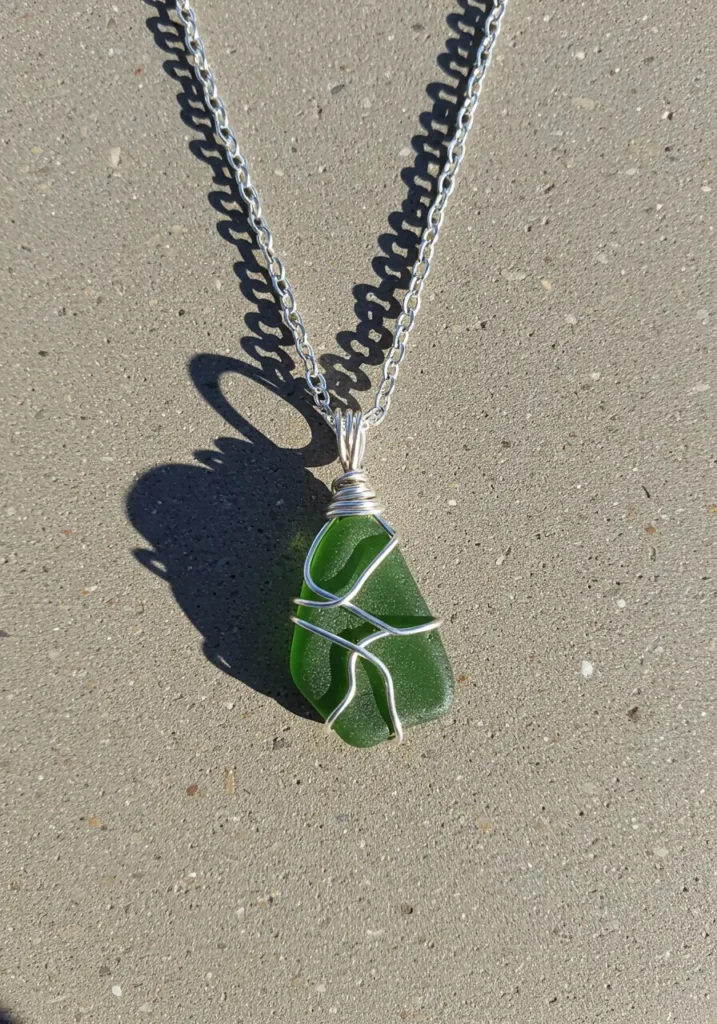
Necklaces and pendants are perhaps the most popular form of Sea Glass Jewelry. A single piece of sea glass, often wire-wrapped or bezel-set, hangs elegantly from a chain. The simplicity allows the unique shape and color of the glass to be the focal point. Various chain lengths and styles create different looks.
Sea Glass Earrings
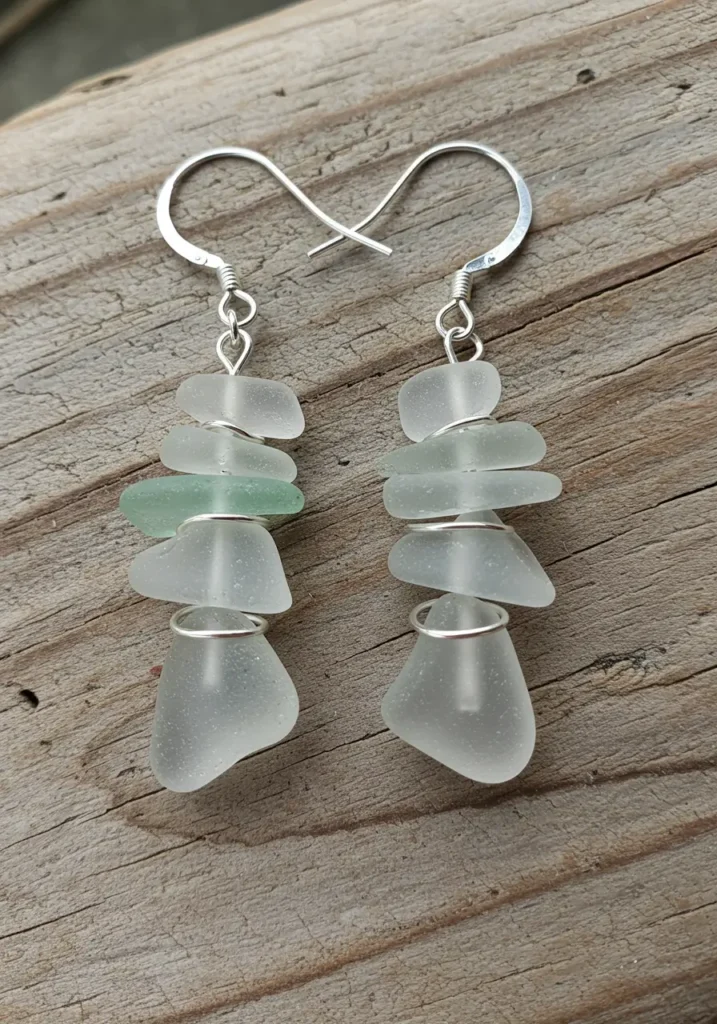
Sea glass earrings come in many forms, from simple drop earrings featuring a single frosted shard to more elaborate designs with multiple pieces or metal accents. Lightweight pieces work best for comfort. The natural translucency of sea glass allows light to pass through, creating a delicate sparkle.
Sea Glass Bracelets and Bangles
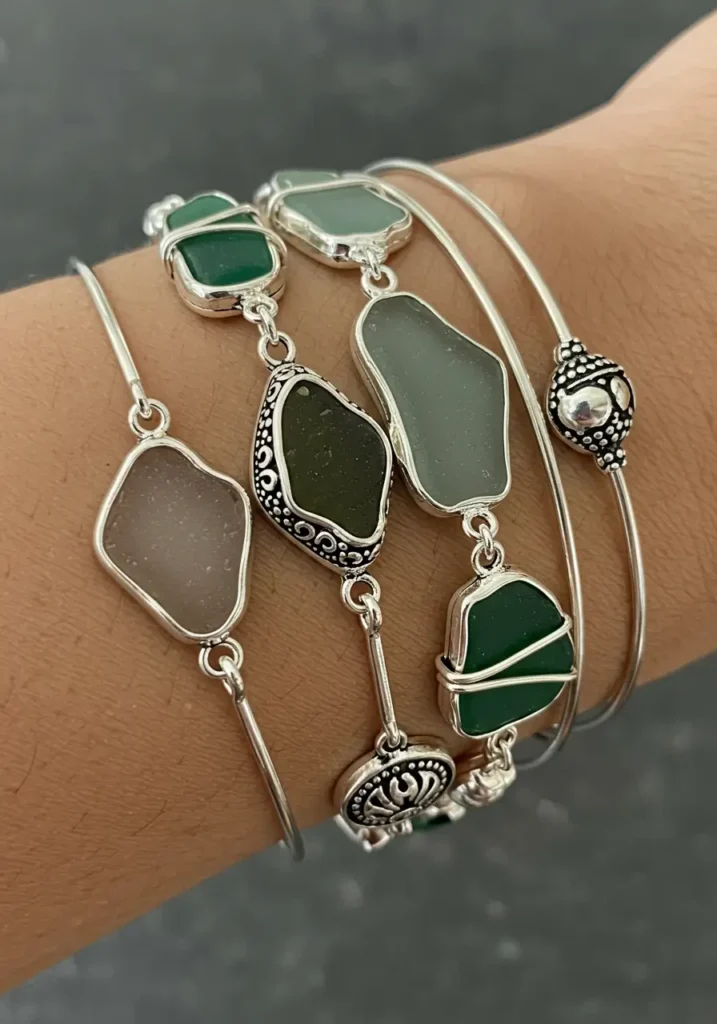
Bracelets incorporate sea glass as charms, main focal points, or integrated into intricate metalwork. Bangles might feature a single piece of sea glass prominently. These pieces add a touch of coastal charm to the wrist. Layering multiple sea glass bracelets can create a bohemian-inspired look.
Sea Glass Rings
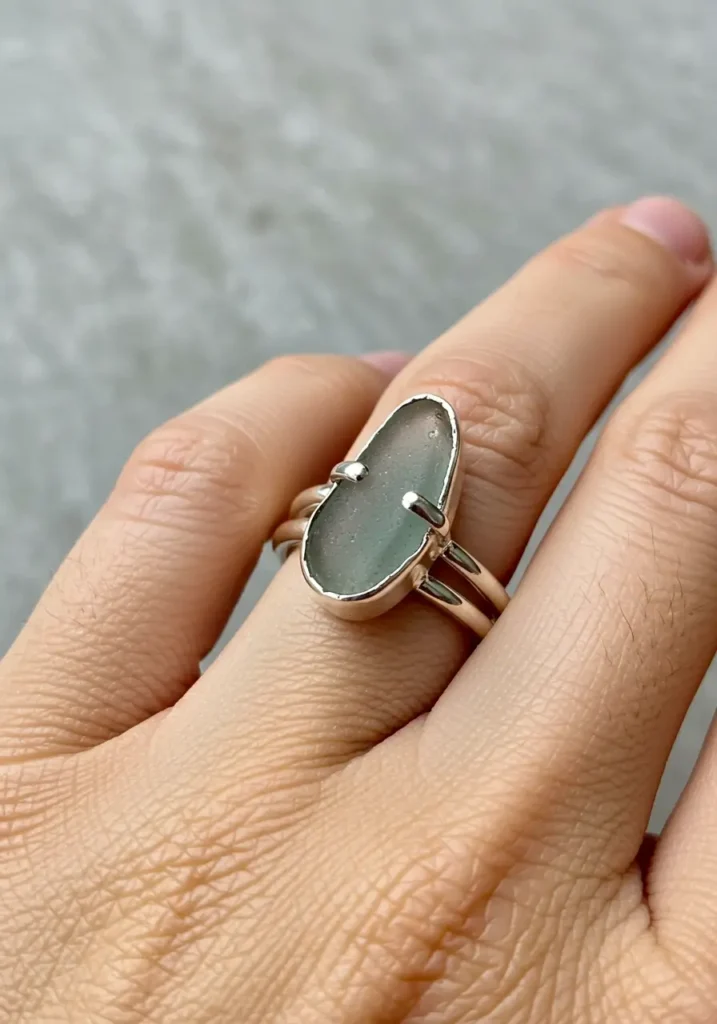
Sea glass rings feature a piece of glass as the centerpiece, often set in a custom bezel. They offer a unique alternative to traditional gemstone rings. Their organic shapes make for striking, one-of-a-kind designs. The choice of metal can dramatically change the ring’s overall feel.
Budgeting for Sea Glass Jewelry: Value and Authenticity
The cost of Sea Glass Jewelry varies significantly based on the authenticity, rarity of the glass, complexity of the design, and type of metal used. Understanding these factors helps you budget wisely.
Affordable Finds (Lower End)
Simple Sea Glass Jewelry pieces, often wire-wrapped with plated metal or featuring common glass colors (clear, brown, green), can be very affordable, ranging from $20-$50. These are often found at local craft fairs, online marketplaces, or small boutiques. They offer an accessible entry point to owning authentic sea glass.
Mid-Range Quality ($50-$200)
Mid-range Sea Glass Jewelry typically features rarer colors (blues, purples), higher quality metals (sterling silver, gold-filled), and more intricate wire wrapping or bezel settings. These pieces showcase a higher level of craftsmanship and more valuable glass. They offer a good balance of cost, unique appeal, and durability.
Premium Pieces (Higher End: $200+)
Premium Sea Glass Jewelry commands higher prices. This segment includes pieces made with extremely rare sea glass colors (red, orange, yellow, black), combined with precious metals (solid gold, platinum), and complex, bespoke designs. Jewelers with exceptional skill and a strong reputation also contribute to higher costs. These pieces are often considered collector’s items or unique investment pieces.
Also Read: Top 20 Custom Engagement Rings – Unique Designs for Your Perfect Proposal
Here are four step‑by‑step sea glass jewelry projects—no‑drill wraps, glue‑bail pendants, drilled charms, and resin mosaics—so you can make pendants, earrings, and more at home. Each uses beginner‑friendly techniques drawn from jewelry educators, with clear safety notes for drilling under water and handling resin.
Tools and safety
Use diamond‑coated drill bits at low speed and drill sea glass fully submerged in water to keep the bit cool, prevent cracks, and flush debris. Keep the drill’s electrical components away from water, apply only light pressure, and start at a slight angle to avoid bit skidding. For no‑drill options, scuff contact points for better adhesive grip, use a quality jewelry glue, and attach a correctly sized jump ring after curing.
No‑drill wire‑wrapped pendant
-
Materials: sea glass shard, jewelry wire, round‑nose and flat pliers, flush cutters, and a jump ring/chain.
-
Make the bail: use round‑nose pliers to form two tidy loops near one wire end, then wrap the short tail around the neck to secure.
-
Position the glass: choose orientation, hold the bail centered at the top edge, and lay the main wire across the front.
-
First wraps: guide the wire around the back, then across the front, keeping tension even for a snug seat.
-
Build the cage: spiral or criss‑cross wraps down and back up the shard, using a smaller lower loop to lock the glass.
-
Secure at the top: bring the wire back to the bail and wrap the neck tightly; trim and tuck ends so they’re smooth.
-
Finish: add a jump ring through the bail and hang on a chain or cord.
No‑drill glue‑bail pendant
-
Materials: sea glass, glue bail, fine sandpaper/file, jewelry adhesive, alcohol wipe, jump ring/chain.
-
Prep surfaces: lightly scuff both the bail pad and the glass where they’ll meet; clean dust and oils before gluing.
-
Glue and set: apply a small bead of high‑quality jewelry adhesive, press the bail onto the scuffed glass, and align straight.
-
Cure fully: allow the adhesive’s recommended cure time before handling to ensure a strong bond.
-
Finish: attach a jump ring through the bail loop and add your chain.
Drilled sea glass charm
-
Materials: sea glass, rotary tool or drill, small diamond‑coated bit, shallow water tub, wood backer, safety glasses, jump ring.
-
Submerge setup: place a thin board in a shallow container, cover with water, and position the glass on the board under water.
-
Start at an angle: set to low speed, begin drilling at ~45° to create a groove, then straighten to vertical with light pressure.
-
Pulse and cool: lift slightly to let water circulate and clear debris, keeping the glass and bit cool to prevent fractures.
-
Optional two‑sided: flip and complete from the other side to reduce chipping near the exit point.
-
Safety: never let any powered drill body contact water; keep only the working tip submerged and drill slowly.
-
Finish: rinse the piece, deburr if needed, then add an appropriately sized jump ring and chain or ear wire.
Resin sea glass mosaic pendant
-
Materials: bezel tray, real sea glass bits, 2‑part resin, mixing tools, torch/pick for bubbles, optional sandpaper.
-
Arrange mosaic: lay small sea glass fragments inside a pre‑made bezel until the arrangement is balanced and secure.
-
Mix and pour: prepare resin per instructions, pour in thin layers over your layout, and remove surface bubbles between pours.
-
Cure and refine: allow full cure, then, for a frosted sea‑glass look, lightly sand the back to add a translucent haze.
-
Hang: drill a small hole if using cast pieces or simply attach a jump ring to the bezel loop and add a chain.
Quick variations
-
Earrings: drill matched shards and hang on ear wires, or use tiny glue bails for no‑drill drops.
-
Wrap styles: try simple diagonal wraps or swirly one‑wire designs to change the look with the same tools.
-
Beginner projects: start with glue‑bail pendants or bezel‑and‑resin mosaics before progressing to drilling and advanced wraps.
Caring for Your Sea Glass Jewelry: Preserving Its Charm
Proper care ensures your Sea Glass Jewelry maintains its unique charm and sparkle for years to come. Gentle handling and regular cleaning protect both the glass and the metal components.
Gentle Cleaning Techniques
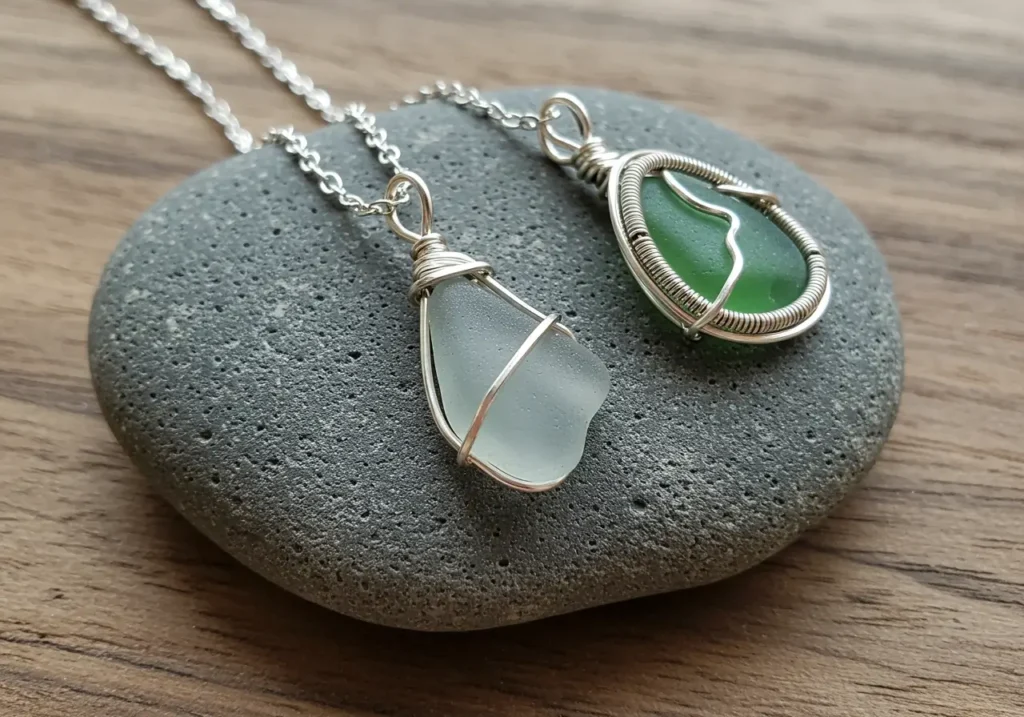
Clean your Sea Glass Jewelry gently. For most pieces with metal settings, use a soft cloth and a mild soap (like dish soap) with warm water. Gently rub the glass and metal. Rinse thoroughly and dry with a lint-free cloth. For intricate wire-wrapped pieces, use a soft toothbrush to get into crevices. Avoid harsh chemicals, abrasive cleaners, or ultrasonic cleaners, which can damage softer metals or remove the glass’s delicate frosting.
Proper Storage: Protecting from Damage
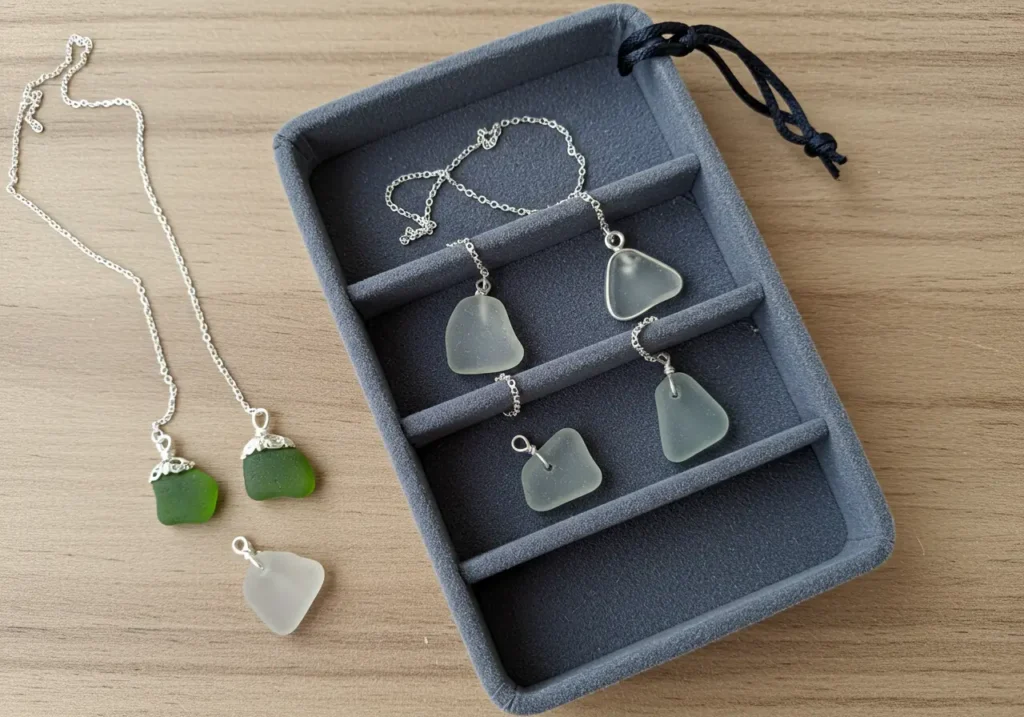
Store your Sea Glass Jewelry in a cool, dry place, ideally in a separate pouch or a jewelry box with compartments. This prevents pieces from scratching each other or tangling. Store away from direct sunlight, which can, over very long periods, potentially impact certain glass colors or accelerate metal tarnishing. Proper storage ensures your jewelry remains pristine.
Avoid Harsh Chemicals and Activities

Remove your Sea Glass Jewelry before engaging in activities that could damage it. This includes swimming in chlorinated pools (chlorine can damage metal), doing housework with harsh cleaners, or engaging in strenuous physical activity. Chemicals, impacts, and excessive moisture can dull the glass or damage the setting. Proactive removal protects your cherished pieces.
Latest Trends and Innovations in Sea Glass Jewelry
The world of Sea Glass Jewelry continually evolves, integrating new design techniques, ethical considerations, and innovative ways to appreciate these natural treasures.
Minimalist Designs with Raw Edges
A growing trend favors minimalist designs that highlight the organic, raw beauty of the sea glass. This includes simple bezel settings or delicate wire wraps that emphasize the glass’s natural shape and unique edges. The focus is on the glass itself, with minimal embellishment, allowing its inherent beauty to shine. This creates a contemporary aesthetic.
Mixed Metals and Unusual Color Combinations
Jewelers experiment with mixed metals (e.g., silver with rose gold accents) to create modern looks. Combining sea glass pieces of different, sometimes unexpected, colors in a single design also gains popularity. This allows for bold and artistic statements, moving beyond traditional pairings. This creative freedom broadens the appeal of Sea Glass Jewelry.
Sustainable Sourcing and Ethical Crafting
The focus on sustainability continues to grow. Artisans increasingly highlight the origin of their sea glass, emphasizing ethical beachcombing practices. They pair sea glass with recycled precious metals or ethically sourced components. This commitment to responsible sourcing and craftsmanship resonates with eco-conscious consumers. This enhances the value proposition of Sea Glass Jewelry.
Making Your Final Decision on Sea Glass Jewelry
Choosing a piece of Sea Glass Jewelry is a decision that connects you to nature, history, and unique artistry. Focus on selecting a piece that resonates with your personal style and appreciates the authenticity of this ocean-tumbled treasure.
Prioritize verifying the authenticity of the sea glass. Look for the frosted patina and smooth, rounded edges. Understand the rarity of the color, as this influences its value. A reputable seller provides clear information on sourcing.
Consider the craftsmanship and metal quality. Choose a setting (wire wrap, bezel, drilled) that complements the glass and suits your lifestyle. Invest in quality metals like sterling silver or gold-filled for durability and longevity.
Do not overlook the personal connection. A piece of Sea Glass Jewelry often carries a story. Choose one that speaks to you, perhaps reminding you of the ocean or a cherished memory.
Remember, each piece of Sea Glass Jewelry is unique. When you select it with care and intention, you acquire a beautiful, meaningful, and sustainable accessory that will be cherished for years to come.
Unearthing Beauty: The Timeless Appeal of Sea Glass Jewelry
Sea Glass Jewelry offers a captivating blend of natural beauty, historical intrigue, and sustainable artistry. Each ocean-tumbled shard tells a unique story, transforming into a one-of-a-kind wearable treasure.
Take time to understand the characteristics of authentic sea glass. Explore the various crafting techniques. Remember that the rarity of color and the quality of the setting influence its value.
As you choose your perfect piece of Sea Glass Jewelry, appreciate its organic charm and the journey it has taken through the tides. Your selection reflects a connection to nature and a love for unique beauty.
By embracing these insights, you acquire more than just an accessory. You possess a piece of the ocean’s magic, a sustainable and meaningful adornment that enhances your style with a whisper of coastal allure.
Frequently Asked Questions About Sea Glass Jewelry
What makes sea glass authentic for Sea Glass Jewelry?
Authentic sea glass is characterized by a frosted, matte surface (patina) caused by saltwater tumbling, smooth and rounded edges (no sharp points), and unique, irregular shapes. These features distinguish it from machine-tumbled or artificial glass.
What are the rarest colors of sea glass?
The rarest colors of sea glass include red, orange, yellow, black (appears black but is very dark green or brown), turquoise, and certain shades of pink and lavender. These colors often come from very old or specific types of glass, making them highly prized.
How is Sea Glass Jewelry made?
Sea Glass Jewelry is commonly made using wire wrapping (encasing the glass without drilling), bezel setting (creating a custom metal rim around the glass), or by carefully drilling a hole through the glass to attach bails or chains.
How do I care for my Sea Glass Jewelry?
Care for your Sea Glass Jewelry by cleaning it gently with a soft cloth, mild soap, and warm water. Avoid harsh chemicals or abrasive cleaners. Store it in a separate pouch or box to prevent scratches. Remove it during strenuous activities or when exposed to harsh chemicals.
Is Sea Glass Jewelry sustainable?
Yes, Sea Glass Jewelry is inherently sustainable. It repurposes discarded glass that has been naturally transformed by the ocean, turning waste into beautiful, wearable art. This aligns with eco-conscious consumption and reduces landfill waste.
This Post Contains Affiliate Links






